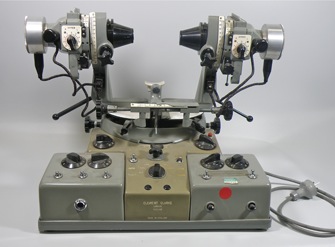Clement Clarke synoptophore
Catalogue Number: 2953 Clement Clarke synoptophore Category: Equipment Sub-Category: Synoptophore, stereoscope Corporation: Clement Clarke Year Of Publication/Manufacture: 1962 Time Period: 1940 to 1999 Place Of Publication/Manufacture: London, England Publisher/Manufacturer: Clement Clarke Description Of Item: Synoptophore made by Clement Clark of London, 420 mm W x 300 mm D x 400 mm H, main body made of grey enamelled metal, with chin rest, two pivoted optical systems, one for each eye. with interpupillary adjustment, with white scales for measuring the rotation of the optical systems and for height and rotation of the targets, a main electrical control panel built-in and there are two removable control systems for control of flashing on the left and for Haidenger Brushes on the right, and an electrical main power supply cord and plugs. Historical Significance: A synoptophore is for the diagnosis and treatment of strabismus and other binocular vision disorders. This instrument represent the zenith of synoptophore development. The first instrument using the principles of the synoptophore was the Priesley-Smith amblyoscope of 1896 that was developed further by Claud Worth in 1902 (See Cat Nos. 1130 and 1796). Mary Maddox, the first orthoptist, developed the kinetic stereoscope for a similar purpose in the 1930s. (See Cat Nos. 1554, 1555). See Cat No. 2415 for a 1930s version of the synoptophore that was the precursor of this 1960s one. See Cat No. 1875 for a brochure describing the range of synoptophores made by Clement Clark Ltd in the 1960s. Elaborate synoptophores fell from favour in the 1980s when some of the treatments it could deliver were shown to be of limited value and simpler tests and treatment devices that could be used for home treatment took their place. Marked on fronT ' CLEMENT CLARKE / LONDON / 2051-35 / MADE IN ENGLAND ' How Acquired: Donated by Clinic of the Australian College of Optometry Condition: Good except for missing central mirror system Location: Archive room. East wall Unit 1 Cupboard |


